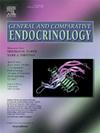通过对野生型和 TR 基因敲除动物进行 ChIP-Seq 分析,发现 TRα 和 TRβ 在肠道重塑过程中的互补和相加功能。
IF 1.7
3区 医学
Q3 ENDOCRINOLOGY & METABOLISM
引用次数: 0
摘要
在哺乳动物出生前后的胚后发育过程中,肠道结构会从胎儿形态急剧转变为成年形态。在有尾目动物的变态过程中,这一过程受到甲状腺激素(T3)通过其受体--T3受体(TR)α和TRβ--的调控。在这里,我们利用热带爪蟾变态过程中的肠道重塑(可作为人类胚后发育的模型)来鉴定与TR结合的基因,并确定TRα和TRβ对靶基因结合的相对贡献。我们首先研究了热带爪蟾变态过程中TRα和TRβ mRNA的定位,发现TRα在变态前至变态末期的肠组织中广泛表达,而TRβ在变态前表达水平较低,但在变态高潮期肠干细胞形成和增殖时表达上调。有趣的是,这两个 TR 基因在包括干细胞在内的不同细胞类型中共同表达。对野生型、TRα或TRβ基因敲除的蜕变前蝌蚪的肠道进行染色质免疫共沉淀(ChIP)-seq分析,确定了许多与TR结合的基因,并揭示了单个TR基因敲除对TR结合靶基因的影响。我们发现,单个TR敲除既减少了TR结合基因的数量,也降低了TR与靶基因结合的程度,其中TRα敲除的影响比TRβ敲除更为显著。另一方面,TR结合基因在三种基因型中基本上是共通的。这些研究结果表明,TRα和TRβ都有助于靶结合,而TRα在前变态肠中的作用更大。本文章由计算机程序翻译,如有差异,请以英文原文为准。
Complementary and additive functions of TRα and TRβ during intestinal remodeling as revealed by ChIP-Seq analysis on wild type and TR knockout animals
Intestinal structure is drastically changed from fetal to adult form during postembryonic development, a period around birth in mammals. This process is regulated by thyroid hormone (T3) via its receptors, T3 receptor (TR) α and TRβ during anuran metamorphosis. Here, we used intestinal remodeling during Xenopus tropicalis metamorphosis, which serves as a model for human postembryonic development, to identify TR-bound genes and determine the relative contribution to target gene binding by TRα and TRβ. We first examined the localization of TRα and TRβ mRNA during metamorphosis in Xenopus tropicalis and found that TRα was broadly expressed in the intestinal tissues from premetamorphosis to the end of metamorphosis, while TRβ was expressed at low levels during premetamorphosis but was upregulated at the climax of metamorphosis when intestinal stem cells are formed and proliferate. Interestingly, both TR genes were co-expressed in different cell types, including stem cells. Chromatin immunoprecipitation (ChIP)-seq analyses of the intestine from wild type, TRα- or TRβ-knockout premetamorphic tadpoles treated with or without T3 for 18 h identified many TR-bound genes and revealed the effects of individual TR knockout on the binding of target genes by TR. We found that individual TR knockout reduced both the number of TR-bound genes and the extent of TR binding to target genes with TRα knockout had a much more dramatic effect than TRβ knockout. On the other hand, the TR-bound genes were largely common among the three genotypes. These findings suggest that both TRα and TRβ contribute to target binding with TRα having a bigger contribution in premetamorphic intestine.
求助全文
通过发布文献求助,成功后即可免费获取论文全文。
去求助
来源期刊

General and comparative endocrinology
医学-内分泌学与代谢
CiteScore
5.60
自引率
7.40%
发文量
120
审稿时长
2 months
期刊介绍:
General and Comparative Endocrinology publishes articles concerned with the many complexities of vertebrate and invertebrate endocrine systems at the sub-molecular, molecular, cellular and organismal levels of analysis.
 求助内容:
求助内容: 应助结果提醒方式:
应助结果提醒方式:


